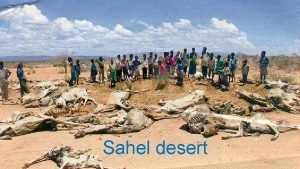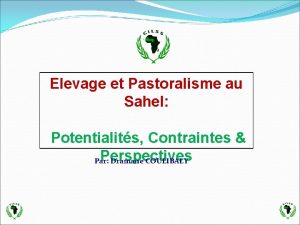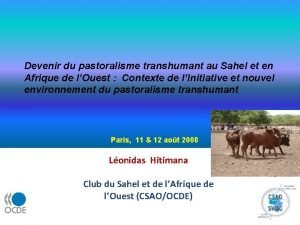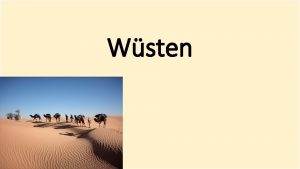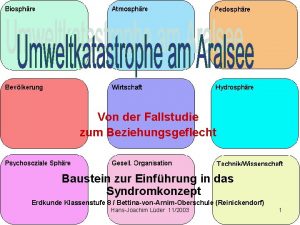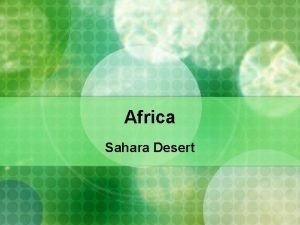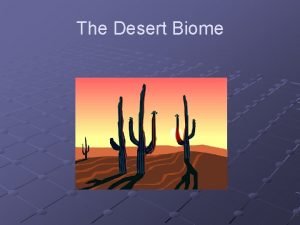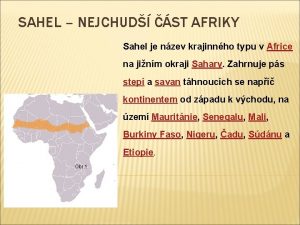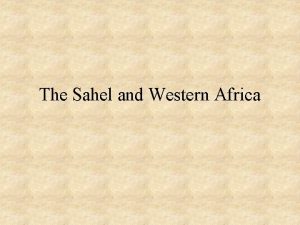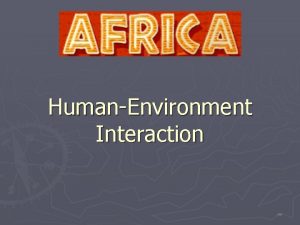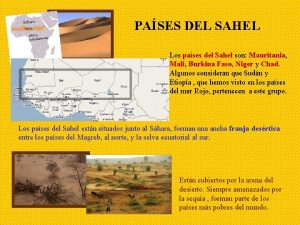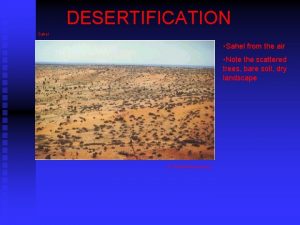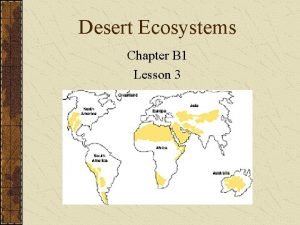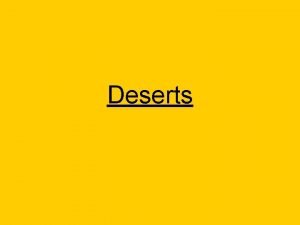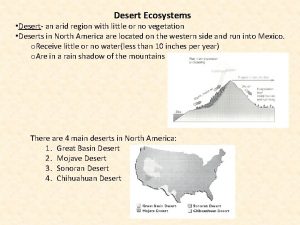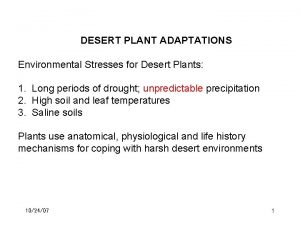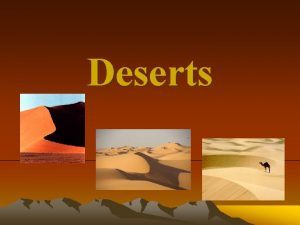Sahel desert Where is the Sahel Using the





















- Slides: 21

Sahel desert

Where is the Sahel? Using the 2 sources describe the location of the Sahel region (4) http: //www. bbc. co. uk/schools/gcsebitesize/geography/water_rivers/drought_rev 3. shtml

Fast facts about the Sahel • The Sahel is an area of ecosystem transition between desert and savannah. • It is 1000 km wide and stretches across Africa from the Atlantic Ocean in the west to the Red Sea in the East. • The Sahel is found in Senegal, Mauritania, Mali, Burkina Faso, Algeria, Niger, Nigeria, Chad, North Sudan, Eritrea, Cameroon, Central African Republic and the extreme north of Ethiopia. • Rainfall totals 100 mm/year, is highly variable and concentrated in a single season of 2 weeks to a few months. • Rainfall is highly variable and drought has been a common feature of the area for around 5000 years. Though below average years have been more common since the mid 1970's. • Low rainfall does not always coincide with famine and hardship. For example, the Fula and Tuareg pastoralists suffered droughts from 1968 to 1974 and again from 1982 to 1984. The recovery time between the droughts was insufficient for them to rebuild their herds so the impact was more severe.


Desertification • When productive land turns to desert

The main reasons for increasing soil degradation are: Population Growth (the population of the region is growing at about 3% a year and doubling every 20 years) • Deforestation (much of it caused by people collecting firewood) • Overgrazing (some of this is caused by loss of land to National Parks and tourist developments and commercial farms) • Colonialism - the creation of borders forced people more into villages making them less nomadic and placing greater pressure on the land. • Rising temperatures (greater evaporation) and reduced rainfall (droughts) • Storms - the rainfall that does take place tends to be in shorter more intense storms that can lead to water erosion.

Watch these 2 videos to find out the background reasons to the issues in the Sahel… • Cause • Effects • Solutions


Effects According to the United Nations Food and Agriculture Organization, 18. 7 million people in the Sahel region faced an extreme food crisis in 2012. Today, 20 million people in the region are at risk of food insecurity and 2. 5 million of them need immediate lifesaving food assistance. An estimated 5 million children younger than 5 will suffer from malnutrion in 2014. Many families were left with nothing to eat and had found their only sustenance in soups made from wild plants so bitter that animals often neglected to eat them. “To make them edible, peasants boil the plants repeatedly so as to get rid of the bitter taste, ” Some households in the Sahel had been without food reserves for some seventh months.

Conflict in Darfur https: //www. youtube. com /watch? v=gxr b-89 Af 8 A Sudan’s Darfur region has been hit by conflict since 2003, killing 250, 000 people and making around 3 million homeless. Previously the environment was already under pressure; ü One year out of every five bring drought, crop failure and livestock loss to Sudan. ü The Sahel’s ability to produce food has not kept pace with its growing population. The environment has played a major role in creating conflict. In 2003 nomadic cattle herders and settled farmers began to fight over water supplies and land. Herders were deliberately prevented from reaching water sources by farmers which led to overgrazing. Once the vegetation was gone their cattle died. In revenge some herders chased farmers from their villages, and cut down their crops and trees. Millions of people fled their land homes. They were housed in refugee camps with help from the UN. But refugees camps create new environmental stress wherever they are located and cause desertification to spread. When people finally return home, further desertification is expected. One charity estimates that each family returning will need 30 -40 tree to rebuild their houses and fences. The desert fringes of Sudan do not have

Climate change • Global dimming: a study by the Commonwealth Scientific and Industrial Research Organization (CSIRO) in 2002 suggested that air pollution changed the properties of clouds. This disturbed the monsoons which in turn caused a shift in the rain belts over the Sahel. Dirty air from Europe, Asia and North America caused the rains of the Sahel to shift southwards and miss the Sahel. • Climate modelling by the National Oceanic and Atmospheric Administration (NOAA) indicates that droughts may be linked to changes in the surface temperature of the sea. • Increases in greenhouse gases (produced by human activity) and aerosol particles are causing a southward shift in the rain belts over the Sahel.

Population growth in desert fringe areas, as in other places, has two components; ü Population growth remains very high in the poorest parts of the Sahel, for reasons linked with poverty, such as lack of education. There were just 30 million people living in the Sahel in 1950. Today the figure is closer to half a billion. By 2050, it is expected to reach one billion. Most of this growth is cause by the high number of children being born, and people living longer than they did in the past. ü Migration brings even greater population pressure. Drought and desertification in one region will displace people to another fragile environment. Desertification occurs there too, as the number of people increases, so the problem gets spread from place to place. In addition to climate change refugees, millions of people have been forced to move into desert fringe areas by armed conflicts in the Sahel region.

Overgrazing If too many goats and cattle are grazed for too long on one site, all the vegetation is eaten and maybe unable to regrow. Nomadic groups used to wonder freely, following the rain wherever it fell. They would leave land before all the vegetation was gone, giving it a chance to recover. Now they cannot, due to new political boundaries, or because large companies have brought up the land rights in a region. Civil war and political instability also force herders to stay too long in places.

Overcultivation Overcropping land can exhaust soil’s fertility. Part of the problem is due to small scale subsistence agriculture. As health has improved over time, more of the children born into farming families are surviving infancy. More crops are planted and some aquifers have been drained dry. Commercial farming makes this situation worse. European companies are using large areas of fragile land in Ghana to grow waterhungry cash crops such as jatropha (which is used to make vegetable oil).

Soil erosion Over cultivation and overgrazing both result in soil erosion. If vegetation has been eaten by cattle or killed by drought, the exposed topsoil becomes baked hard by sunlight. When it finally arrives intense rain washes over the soil rather than soaking into the ground. As it flows it carried the topsoil away. Once the soil has eroded, it becomes impossible for the vegetation to grow back.

Solutions 1: Food aid

Solution 2: Sustainable farming- The Great Green Wall 1. How does it work? 2. What are the benefits? 3. What are the issues?

Figure 1 The Sahel desert is experiencing desertification at an alarming rate. Project 1 A project focusing on promoting sustainable farming methods. As part of sustainable farming, farmers plant trees to help bind the soil together and reduce the loss of fertile soil. Farms also create terraces on hills which prevent rainfall run off on sloping land, therefore keep the soils fertility high. Project 2 Unusually trees are removed for cooking, however this is unsustainable. Practice Action are tackling the issue with the use of more fuel efficient wood stoves, which are both affordable and easy to use. Therefore cutting the amount of risky trips for firewood and allowing more trees to grow. Also burning smaller amounts of wood means that less smoke will enter their lungs and their homes. Project 3 Laying low stone bunds in fields is a well known technique as a result various government and non government programmes are promoting the large scale introduction of the technique. The stone bunds form a barrier that slows down water runoff, allowing rainwater to seep into the soil and spread more evenly over the land. This slowing down of water runoff helps with building-up a layer of fine soil and manure particles, rich in nutrients.

Exam question Three projects have been suggested to try and reduce the rate of desertification in the Sahel. Which of the three projects do you feel is the most sustainable for the LIC country of Sudan? Use evidence form the resources booklet and your own understanding to explain why you have reached this decision. Level Below C ü Demonstrates basic application of knowledge and understanding in evaluating the effectiveness of the project in terms of socioeconomic and environmental benefits. ü Applies knowledge and understanding to make a decision on a limited range of supportive evidence, making basic links between the different topics. ü Selects information with some links to the Level 2 (clear) C-B grades ü Demonstrates reasonable application of knowledge and understanding in evaluating the effectiveness of the project in terms of socioeconomic and environmental benefits. ü Applies knowledge and understanding to make a decision on a reasonable range of supportive evidence, making clear links between the different topics. ü Selects appropriate Level 3 (detailed) A-A* grades ü Demonstrates thorough application of knowledge and understanding in evaluating the effectiveness of the project in terms of socioeconomic and environmental benefits. ü Applies knowledge and understanding to make a decision on a wide range of supportive evidence, making detailed links between the different topics. ü Communicates findings


Examples of 7 mark questions • 2013: For a named area or country you have studied which suffers from food shortage, explain why there is a shortage of food. [7] • 2016: For a named country or region you have studied, describe the effects of food shortages on the people who live there. [7] • 2007: In many parts of the world the natural environment presents hazards to people. Choose an example of a drought. For a named area, describe the short-term and long-term effects of the example which you have chosen on people living in the area. [7]
 Sahel desert location
Sahel desert location The soldier decided to desert his dessert in the desert
The soldier decided to desert his dessert in the desert Physical geography of west africa
Physical geography of west africa Sahel rainfall graph
Sahel rainfall graph Pastoralisme au sahel
Pastoralisme au sahel Pastoralisme au sahel
Pastoralisme au sahel Kolonialmächte
Kolonialmächte Sahara and sahel observatory
Sahara and sahel observatory Sahel bölgesi
Sahel bölgesi Amurdarja
Amurdarja System collections generic
System collections generic Defrost using internal heat is accomplished using
Defrost using internal heat is accomplished using Quá trình desamine hóa có thể tạo ra
Quá trình desamine hóa có thể tạo ra Vẽ hình chiếu vuông góc của vật thể sau
Vẽ hình chiếu vuông góc của vật thể sau Công thức tiính động năng
Công thức tiính động năng Tỉ lệ cơ thể trẻ em
Tỉ lệ cơ thể trẻ em Thế nào là mạng điện lắp đặt kiểu nổi
Thế nào là mạng điện lắp đặt kiểu nổi Dot
Dot Lời thề hippocrates
Lời thề hippocrates Bổ thể
Bổ thể Vẽ hình chiếu đứng bằng cạnh của vật thể
Vẽ hình chiếu đứng bằng cạnh của vật thể độ dài liên kết
độ dài liên kết
